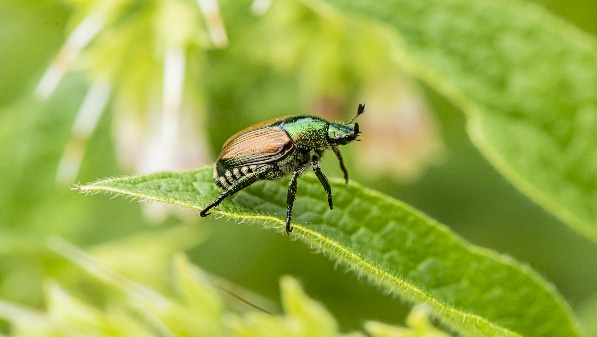Soybean Cyst Nematode
- Effect: Roots will be stunted, nodules fewer, may allow for other diseases to come in and infect the plant, can cause stunting and yellowing of plants usually in an oval or circular pattern in the field it is commonly confused with iron deficiencies, drought stress, herbicide injury, or other diseases.
- ID: Associated with sandy, dry soils, found on the roots of the plants, smaller than nitrogen nodules. They start as yellow and then turn to a tan color as they mature and form cysts; like high pH soils as well.
- Control: Rotate with a non-host crops such as corn and alfalfa, select for resistant or more tolerant varieties. Once they are present in the soil they can never be eliminated but they can be managed. Make sure fields are adequately fertilized.
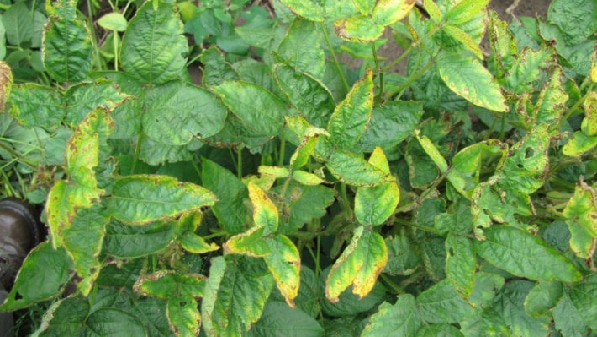
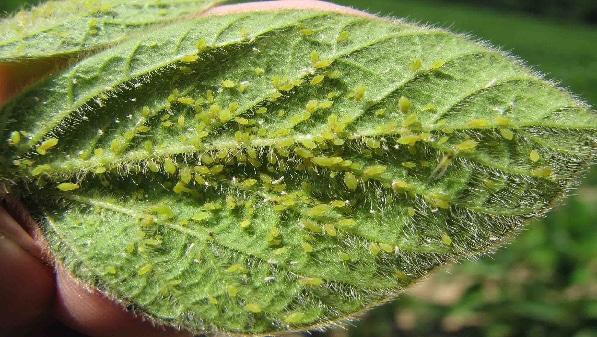
Aphids
- Effects: Yellowing edges of leaves, which commonly looks like a potassium deficiency, curled leaves & stunted plants. Removes moisture needed for growth and nutrients needed for seed production, they can transmit other viruses.
- ID: Oval or pear shaped, less than 1mm in length, usually a light/lime green, found on the underside of the leaves in the upper canopy.
- Control: Lady beetles are natural predators, low temperatures promote reproduction, neonicotinoids should be considered in stands that are planted late in the season, economic threshold- should be sprayed before there are 1,000 per plant at R5 stage.
Spider Mites
• Effects: Feeds on the plant juices and cause moisture and nutrients to be removed, causing the leaves to appear yellow/whitish in color on the top side, large populations and heavy infestation may cause stippling of leaves.
• ID: Extremely small ranging from 1/60-1/80 of an inch (about the size of a grain of salt), greenish/yellow and will have 6 or 8 legs, found on the underside of the leaves in the upper canopy, have a piercing/sucking mouth that feeds on plant juices, more prevalent in droughty or drought prone areas, start at the field edge in a half circle pattern and begin to spread out- creating a larger and larger half circle if left unchecked.
• Control: Natural predators such as thrips and fungi will keep populations in check, spraying is recommended if leaves are covered 20-50% before pod set or 10-15% after pod set, spraying pyrethroids may affect natural predator populations as well.
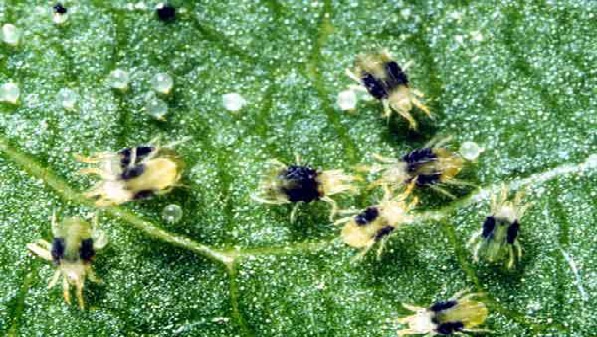
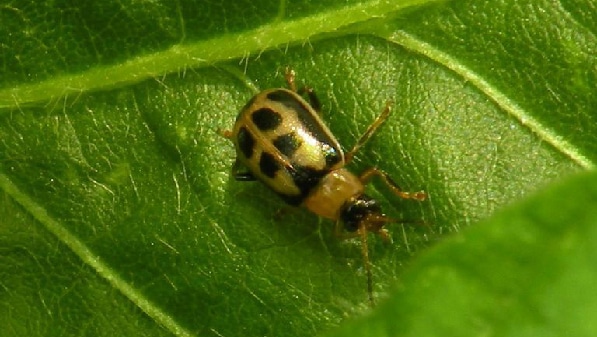
Bean Leaf Beetle
- Effects: Causes reduction in quality and yield, causes green stem and a delay at harvest, defoliates plant leave.
- ID: Adults are about 1/5 inches long, range from a dark yellow to an orange or red, their wings will often have rectangular marks-normally 4 but some only have 2 and some don’t have any, identifying mark is the triangle that is right behind the head/neck region, the larvae resemble corn root warm and are found near the soil with a white body and black head, commonly can be found feeding on nodules of the bean plant.
- Control: More commonly found in the south as they overwinter in hedge rows and fence lines but are killed if exposed to temperature below 14 degrees, there are no varieties that show resistance to this pest, consider the use of an insecticide if the field has a history of BLB and consider rotation with no-host crops.
Japanese Beetle
• Effects: Defoliates the crop, leaving a lattice appearance on the leaves, usually heaviest impact is seen on the uppermost leaves, severely injured crops will turn brown and drop their leaves, the larvae will feed on the root hairs causing injury to the roots and a decrease uptake in nutrients.
• ID: About ½ inch long, metallic green with a bronze color for the wings. Eggs are a translucent to creamy white and as they mature begin to turn cylindrical. The larvae (also known as grubs) are about 1 inch long and are creamy white with a brown head; commonly confused with white grubs at the larval stage but can be identified by the V shaped pattern if the bristles on the raster.
• Control: Very challenging to manage this pest as they are difficult to predict where they will be. A large presence of larvae does not mean that high feeding will occur. For the adults scouting should be a priority as there are economic thresholds—40-50% defoliation up to V7 stage, 15-20% defoliation during pod development and fill, >25% from pod fill to harvest. There are several labeled insecticides for controlling Japanese beetle in soybeans, be sure to weigh the economics of it as they usually don’t cause a lot of economic loss, but it will control the white grub population the following year (if corn is in rotation).
